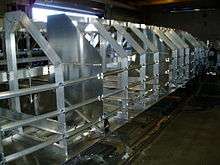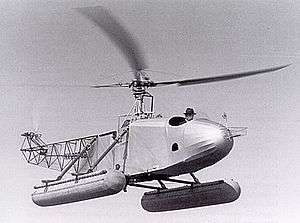Float (nautical)
Floats (also called pontoons) are airtight hollow structures, similar to pressure vessels, designed to provide buoyancy in water. Their principal applications are in watercraft hulls and aircraft floats, floating pier and pontoon bridge construction, and marine engineering applications such as salvage.
Use
Floats make up the multipart hulls of catamarans and trimarans and provide buoyancy for floatplanes and seaplanes.[1] They are used in pontoon bridges, floating piers, and floats anchored to the seabed for recreation or dockage. They are also used in shipbuilding and marine salvage, often deployed uninflated then pressurized to raise a sunken object.
Construction

Pontoons for marine industrial uses are usually fabricated from steel plate and sheet. Pontoons as parts of watercraft and aircraft are more typically molded in glass-reinforced plastic. Before the 1970s, glass-reinforced plastic was rare; older techniques include those of traditional wooden boatbuilding as well as plywood over wooden ribs or metal sheets over metal ribs (aluminium or steel), reflecting the prevailing practice in aircraft and boats. In model building, floats can easily be carved out of solid blocks or laminated sheets of foam.[2]
Gallery
 Small open catamaran.
Small open catamaran. Foldable trimaran with the floats in extended position.
Foldable trimaran with the floats in extended position. Floats in a small floatplane.
Floats in a small floatplane. Floats created the first practical amphibious helicopter in 1941
Floats created the first practical amphibious helicopter in 1941 A helicopter pontoon augmented by an inflatable emergency pontoon shown in black
A helicopter pontoon augmented by an inflatable emergency pontoon shown in black The underside of a boat during construction
The underside of a boat during construction
See also
References
| Wikimedia Commons has media related to Pontoons. |
- ↑ The Cruising Multihull. 978-0070698680: International Marine/Ragged Mountain Press. 1996. p. 45. Retrieved 2009-05-27.
- ↑ http://www.rc-float-flying.rchomepage.com/Glow%20Cores/floatcores.htm